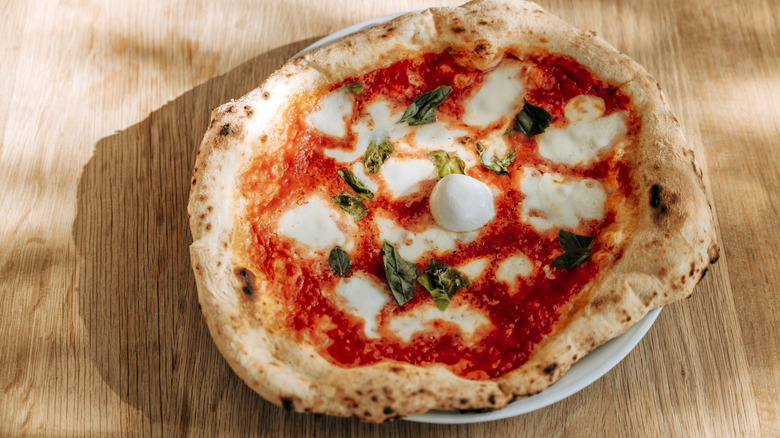The Biggest Presentational Change Tourists Should Expect When Ordering Pizza In Italy
One of the most popular cuisines in the U.S., Italian food has made its way into homes and restaurants all across the country (and the world). From hearty pasta dishes to creamy risottos and savory meat dishes, Italian cuisine is bursting with flavor and tradition. However, among all these delicious options, there's one very special dish — worth an estimated $18 billion — that stands out as a favorite: pizza.
Originally created in Naples in the late 18th century, pizza quickly gained popularity with the royals during a visit to the region. Since then, the dish has made its way across the globe, adapting to local tastes and preferences, and becoming a worldwide classic. However, despite its international popularity, there's a lot more to pizza than meets the eye. In fact, so-called "authentic" pizza — as in, the way Italians prepare and serve it — is actually quite different from what you might expect to see at a restaurant stateside.
Specifically, one of the most surprising differences for visitors traveling Italy is that local pizzas are typically served unsliced. This is to help maintain the pizza's integrity and ensure that it's every bit as delicious and fresh as the chef intended.
Italian pizza isn't cut into slices
Order a pizza while you're in Italy, and you might be surprised to find that it'll arrive at the table whole, instead of carefully split into neat, triangular slices. No, this isn't an oversight on the restaurant's side — it's a very deliberate choice that ultimately serves to enhance your dining experience. The main reason for this is that unsliced pizza is meant to preserve the dishes' integrity and flavor. After all, authentic Italian pizza generally features fresh, high-quality ingredients that can create a runny topping situation. That way, by serving the pizza unsliced, restaurants can prevent these toppings from sliding off or soaking into the crust — keeping the edges crisp and the center flavorful.
@katarina.etiquette Pizza might be one of the most popular dishes originating from Italy 🇮🇹🍕 In most parts of Italy, you will be served an unsliced pizza, so the usage of fork and knife will be necessary, especially in the beginning. Etiquette books are relaxed when it comes to eating pizza as it can be eaten with both cutlery (in formal settings) and hands (informal settings) 😉 Big thanks to @MARIUCCIAGROUP for having me ❤️ Highly recommended for an authentic Neapolitan pizza in Rome! #etiquette #etiqueta #etiquettetips #pizzaetiquette #tablemanners #manners #elegance #elegantlady
On top of that, there's another big reason behind the tradition: Temperature. Pizza in Italy is meant to be enjoyed piping hot — as in, straight-from-the-oven hot. And, unfortunately for the more impatient eaters, slicing the pizza before serving would easily allow the heat to escape. Lastly, Italians also take their pizza eating very seriously, and typically believe that a whole pizza is meant to feed one single person. As such, slicing a pizza would ultimately imply that it's going to be shared — and no one wants that.
Don't worry, though — you won't just be left to your own devices trying to figure out how to eat your meal. Most Italian restaurants will provide you with a knife and fork to easily cut into and slice the pizza yourself. As for how to actually eat it once you've sliced it, feel free to keep cutting at the center before putting your cutlery down to grab the crispier, more manageable edges with your hands.
Other Italian mealtime quirks you might not be used to
Beyond unsliced pizza, Italians have plenty of other customs at mealtime that might throw unsuspecting visitors for a bit of a loop. First on the list is the stark differences between what's considered authentic and what you're used to eating back home. For example, in terms of toppings, there's actually a popular type of pizza you'll never find in Italy: pepperoni. That said, instead of the "American-ized" version, your best bet is to order a "salamino piccante" or "salsiccia piccante" pizza from the menu. Both are the closest to "pepperoni," and will surely satisfy that craving.
In addition to certain pizzas you might have back home that simply won't appear on the menu once you land in Italy, there's also the notable absence of dips, sauces, and condiments at the table. For instance, albeit an iconic add-on back in the U.S., asking for "ranch sauce" at a local Italian restaurant will immediately make you look silly. The same goes for other saucy condiments like ketchup or mayo. The reason for this is that Italians believe their dishes are perfectly seasoned as they are, and adding any extra condiments is basically akin to telling the chef that they don't know how to cook.
Finally, when dining in Italy, you might also notice that meals are all served separately and in a specific order. Unlike in some countries where all dishes arrive at once, Italians typically enjoy their meals in courses. Start with "aperitivo" or "antipasti" (appetizers), followed by "primi" (first courses like pizza, pasta, or risotto), then "secondi" (main courses, usually meat or fish), and finally "dolci" (desserts). Oh, and as for coffee, make sure to never order a cappuccino after noon — otherwise, you might also get served a judgmental look alongside your food.


